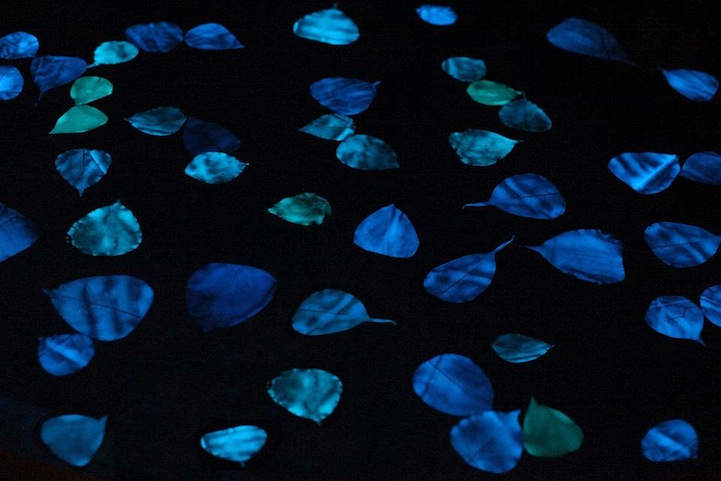Ever wondered what would you get if you were to put a chemical engineer, a graphic designer and a research scientist together? Well, the answer is quite simple and yet unexpected–beautiful art.
While most artists paint to imitate nature, others have found a way to make their work with aid from the natural world. Bioluminescent art is an amalgam of science and creativity. In a wondrous combination of nature and design, bioluminescent art involves using naturally glowing bacteria to create intricate and deliberate formations only visible when the lights are out.
1. Bioglyphs
The three professionals mentioned above came together to create ‘BIOGLYPHS’, a collaborative gallery at Montana State University-Bozeman a couple of years ago.
Taking note of the glowing potential of bioluminescent bacteria, a team led by researcher Betsey Pitts decided to make full-scale works of art. Pitts and her comrades “painted” a solution containing bacteria harvested from marine environments onto petri dishes, filled the dishes with agar, glued them, and allowed the colonies to form.
Pitts, director of the project and a research scientist at the Center for Biofilm Engineering, said the BIOGLYPHS project involved “some microbiology training, imagination, and a lot of petri dishes.”
This kind of art doesn’t use paint or paper. Bioluminescent art is also different in that it needs to be maintained from start to finish. The petri dishes were filled with artificial seawater agar and glued closed just so with plenty of oxygen and kept at a temperature below 70 degrees Fahrenheit.
“This was all done in an afternoon, and the organisms were grown up and glowing in the dark by the next morning, when the show opened,” said Pitts. As the nutrients gave out over time, the light production slowed and then finally stopped — thus ending the exhibit.
Check out a few of the resulting canvases after the jump.
IMAGE COURTESY – biofilm.montana.edu
2. Living Drawings
Another series of bioluminescent bacteria drawing was done by artist and geneticist Hunter Cole called ‘Living Drawings’ driven by the concept of life and death. The artist also working on a series called ‘Living Light’, in which she photographed people and objects using only the light of bioluminescent bacteria.
The bioluminescent bacteria create their own light via expression of the lux genes. Hunter Cole created controlled line drawings using bioluminescent bacteria. First the bacteria are allowed to grow in the host environment followed by their participation as collaborators in the art as they grow.
Initially when the bacteria appear with bright light, they are photographed. In the next couple of days, the bacteria uses up the available nutrients, gradually dying-off.
The artist took advantage of the bacteria’s equal brightness along the entire line of drawing. Regions where most of the bacterial growth occurs die the fastest because there are limited nutrient resources in the seaweed nutrient agar. As the bacteria die the drawing changes and slowly fades into complete darkness.
IMAGE COURTESY – huntercole.org
Both an internationally renowned artist and also experienced geneticist, Cole reinterprets science as an art through abstractions, digital art and installations. The artist approaches the expression of ideas through blending art and science as a source for new perspectives, understanding, and ultimately new meaning about each discipline. In order to offer the students an opportunity to create innovative artworks in a biology laboratory, she started a course Biology through Art at her university.
3. Obon in Japan
Yet another unorthodox use of the phenomenon of bioluminescence came forth from artist Miya Ando and photographer L. Young. With a different kind of bioluminescence, Ando’s exhibit involved 1,000 Bodhi leaves being released in a pond, the leaves being painted with a nontoxic glowing phosphorescent pigment, the project was inspired by the ancient Japanese festival, Obon.
During the day the leaves would “recharge” and at night would give off a ghostly, ethereal glow much like the light of a firefly. Titled Obon, the installation was inspired by a Japanese Buddhist festival of the same name that honours the spirits of one’s ancestors. The leaves were also meant to simulate Puerto Rico’s bioluminescent bays, a natural phenomenon caused by dinoflagellates, photosynthetic underwater organisms that emit light when agitated.
“It is believed that during this three-day ceremony the spirits of one’s departed family members and ancestors return to the home and are reunited with their loved ones,” said Ando.
Lanterns are hung inside the house to welcome the spirits inside, and on the evening of the last day of the ceremony, lanterns are floated on rivers to guide the spirits back to the netherworld.
Named after the Japanese Obon Festival, which commemorates the spirit of the dead and is said to guide ancestral spirits home with floating lanterns, Ando’s floating poetry also mimics bioluminescent bays in Puerto Rico that are populated by singled-celled dinoflagellates.
IMAGE COURTESY – mymodernmet.com
“There is a beautiful, non-denominational notion of respect, interconnectivity, history and memory that is celebrated with the festival of Obon,” Ando said.
Describing the exhibition, the artist said, “The leaves sat in the pond all day and were very unassuming and clear but all the while they were absorbing light. Then visitors arrived and in the darkness I was amazed because there were so many people at the unveiling yet it was totally quiet as people stood and sat at the edge of the pond and just watched these little leaves glowing and floating and moving slowly around.”
The rising popularity of bioluminescent art is a friendly reminder of the fact that art is a dynamic and versatile form of expression that is not merely limited to the use of conventional paints and canvases but is reminiscent of a potpourri of peculiar and quirky ideas.




















